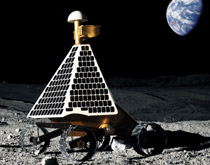
The lawn in the Pittsburgh suburb is snow covered on Christmas Day, 1954. Inside the modest home, a red-headed six-year-old tyke excitedly unwraps his gifts. His favorite is a toolbox. Perfect, he thinks, for building a spaceship. He heads into the snowy cold in search of any mechanical and electronic marvels to be found in the dump at the end of the block. He discovers a "magnificent" discarded radio that will make a great control console. His rocket ship never does take off, but that Christmas Day offers a glimpse of what Larry "Red" Whittaker is doing today.
In 2007, Google announced its Lunar X Prize—a race to send a robot to the moon where it must travel 500 meters and transmit high-definition video back to Earth. Total prize money: $30 million! Game on for Whittaker (E'75, '79), a Carnegie Mellon Robotics Institute professor who became something of a legend for helping with the cleanup of the 1979 nuclear accident at Pennsylvania's Three Mile Island. His robots went into the radioactive-contaminated site, which was too dangerous for humans. Nearly 30 years later, the same year the Lunar X competition was announced, his legend grew further as his team won DARPA's $2 million robotic vehicle race, beating out competitors from the likes of, among others, Cornell, MIT, Penn, and Stanford.
For the Lunar X prize, Whittaker has enlisted space travel entrepreneur David Gump as president of Astrobotic Technology, Inc., which Whittaker chairs. They've forged a plan to win $20 million from Google for landing first, plus another $4 million in performance bonuses, as well as NASA's $10 million landing bonus and Florida's $2 million launch prize—$36 million total for those keeping score.

Just a few months ago, Astrobotic signed a contract with SpaceX, a commercial space travel company, to launch Astrobotic's robotic payload to the Moon. The plan is for SpaceX's Falcon 9 rocket to start Astrobotic's journey to the Moon. Once separated in space from Falcon 9, Astrobotic's lunar rocket will then orbit the moon to align for landing. If all goes well, the spacecraft will have a soft, precise touchdown through technologies pioneered by Whittaker's DARPA team for guiding autonomous cars. The lander will then extend a pair of ramps for Astrobotic's rover to drive itself onto the surface for lunar exploits during the day; it will hibernate through the night.
In addition to the prize money, if Astrobotic wins the race, it will sell lunar expeditions to interested commercial enterprises. One invited guest will be Moon Arts: Carnegie Mellon Art Professor Lowry Burgess has brought together a group of artists, scientists, and engineers to generate a dozen visionary Moon Art projects, such as employing the robot to carry out choreographed activities.
Make no mistake, though, Lunar X is a fierce competition. The final cut includes 29 teams from 17 nations. But of all the teams, Astrobotic is the frontrunner, having the earliest projected launch date, December 2013, some 59 years since Whittaker received his first toolbox.
—Tom Imerito



